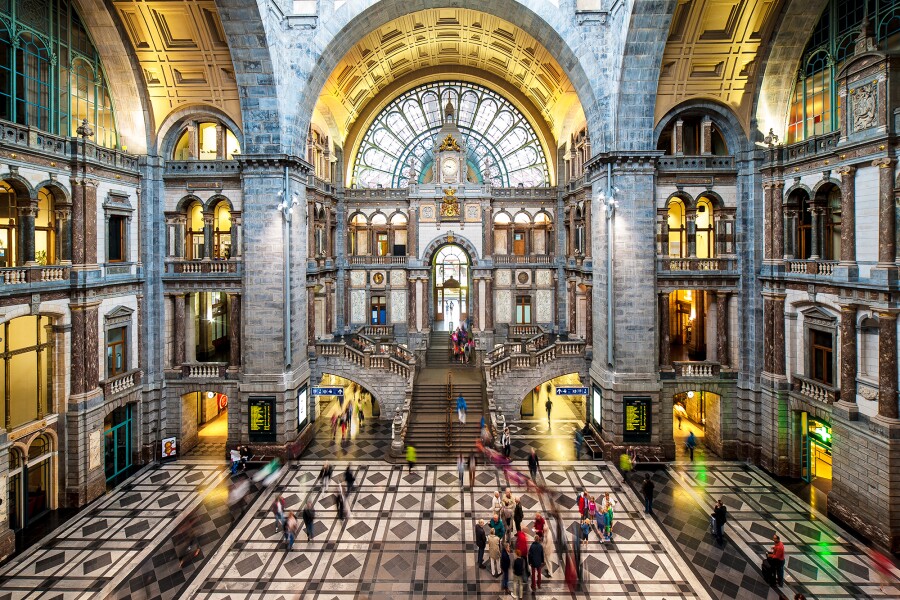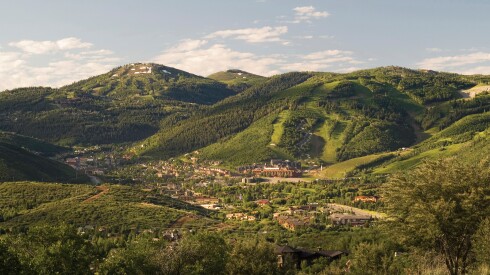As a Midwesterner accustomed to functional but far-from-glamorous Amtrak hubs, I didn’t know I could be wowed by a train station until I visited the Estación de Atocha in Madrid. Struck by the sun streaking in through the curved glass roof and the tropical plants taller than the house I grew up in, I resolved that every time I visited Europe, I’d take time to visit these impressive terminals.
European train stations—such as the classic red-brick St. Pancras in London or the old-meets-ultra-modern Strasbourg-Ville in France—are more than transit stops. They’re treasures of the golden era of train travel, architectural wonders, and community hubs where locals and visitors alike shop, eat, and take in live music and art exhibitions.

You’d be forgiven for mistaking Milano Centrale for an opera house.
Photo by iryna1/Shutterstock
Milano Centrale
Milan, Italy
Milano Centrale is massive, with 24 platforms that serve approximately 320,000 passengers daily. And with its bombastic sculptures and eclectic mix of architectural styles (including art nouveau and art deco), the exterior looks more like a royal opera house or palace. The station was built between 1912 and 1931, and its original simple design was heavily ornamented at Mussolini’s behest to glorify the fascist regime.

The historic Gare Ville station is surrounded by a glass pod, which protects the structure from the elements.
Photo by Maria Sbytova/Shutterstock
Strasbourg-Ville
Strasbourg, France
In 2007, the stately 19th-century Gare de Strasbourg-Ville and its early 20th-century addition were encased in a shiny glass pod; this time-capsule design leaves the historical building unmodified but protected from the elements. It also allowed for a sizeable expansion at what is now the second largest rail hub in France. (It served nearly 24 million passengers in 2023.)

From the street, St. Pancras International is pure old-fashioned elegance, but inside, it’s exciting and modern.
Photo by Uwe Aranas/shutterstock
St. Pancras International
London, England
The epic red-brick facade of St. Pancras International is eye-catching, even in the hubbub of central London. In true Victorian Gothic fashion, an imposing clock tower competes for attention with rows of arched windows at this restored 19th-century station. With its 2007 extension, St. Pancras houses 15 train platforms, over 50 shops and restaurants, a five-star hotel, public pianos, and benches made from the 2012 London Olympic rings.

Antwerp’s ornate central station is sometimes called the “railway cathedral” by locals.
Photo by Only Fabrizio/Shutterstock
Antwerpen-Centraal
Antwerp, Belgium
Despite the stream of busy commuters, Antwerpen-Centraal’s main hall feels like a sacred space with its grand staircase, lacy iron-and-glass windows, shining marble floors, and a dome inspired by the Pantheon in Rome. It’s no wonder that the station’s local nickname, Spoorwegkathedraal, translates to “railroad cathedral.” First opened in 1905, and updated and expanded between 2000 and 2009 to accommodate high-speed trains, the station has 14 platforms on three levels.

The entrance to Helsinki’s main rail station is flanked by a quartet of tall art nouveau “lantern bearers.”
Photo by George Trumpeter/Shutterstock
Helsinki Central Station
Helsinki, Finland
This 1919 art nouveau train station is used by approximately 250,000 passengers daily, making it Finland’s most-visited building. It’s the brainchild of architect Eliel Saarinen, the father of Eero, whom most Americans know for the Gateway Arch in St. Louis. While the red-brown Finnish granite–clad structure is striking, what really steals the show are the two pairs of massive, lantern-carrying statues flanking the main entrance, known as the Lyhdynkantajat, or “lantern bearers.” A glass and steel roof designed by Esa Piiroinen to protect travelers from the elements was added over the central platforms in 2001.

In the 1980s, Atocha train station’s original building was transformed into a large atrium.
Courtesy of ADIF Railways
Madrid Atocha
Madrid, Spain
The Spanish capital’s eclectic Atocha station opened in 1892 after an earlier station was destroyed by a fire, and the train shed’s arched steel-and-glass roof may hint at architect Alberto Palacio’s frequent collaborations with Gustave Eiffel. When traffic at the station outgrew the original building in the 1980s, an annex with 25 platforms was added, and the old platform area was converted into an atrium with several thousand tropical plants from around the world.

The tile murals at São Bento station tell stories of Portuguese history.
Photo by Kartinkin77/Shutterstock
São Bento Station
Porto, Portugal
Built on the site of a former Benedictine monastery and opened in 1916, this rail station is one of Porto’s most popular attractions thanks to the floor-to-ceiling tile friezes in the main hall. Painter Jorge Colaço used nearly 20,000 blue-and-white painted azulejo tiles to bring to life pastoral scenes, the history of transport in Portugal, a royal wedding, and the Portuguese conquest of Ceuta on the northern coast of Africa.

The red-brick Amsterdam Centraal Station looks more like a palace than a train station.
Courtesy of Roel Baeckaert-Rechtenvrij/Amsterdam Marketing
Amsterdam Centraal Station
Amsterdam, Netherlands
From the great mind of Pierre Cuypers, the man behind the Rijksmuseum, comes this palatial train station. Opened in 1889, the Amsterdam Centraal mixes English, Flemish, French, and Dutch influences into a unique style that includes Gothic and Renaissance revival elements, complete with turrets and a roof spanning 131 feet. But the building’s support system is perhaps more impressive: 8,687 wooden piles pounded into three artificial islands loft it over the IJ River.

In 2009, a group of locals restored Wemyss Bay rail station to its former floral glory.
Photo by Blue Kiwi Camera Club for FoWBS
Wemyss Bay
Wemyss Bay, Scotland
While not as grand as some of the other entries on this list, this 1903 Queen Anne–style station an hour west of Glasgow is oozing with charm. Somehow cottage-like despite its 60-foot clock tower, it’s the last remaining station built by the former Caledonian Railway Company. The station was once renowned for displays of hanging baskets and potted plants in its glass-canopied waiting areas, but it fell into disrepair during the 1970s and ’80s. A group of locals adopted the station from ScotRail in 2009 and opened a charity bookshop on site to raise funds to decorate the station inside and out with floral displays.

Train station restaurants don’t come much grander than Le Train Bleu at Gare de Lyon.
Photo by Boris-B/Shutterstock
Gare de Lyon
Paris, France
One of the seven main railway stations in Paris, the current iteration of the Gare de Lyon was built in 1900 in time to impress the world for the Paris Exposition. The 12th arrondissement terminus is a Belle Époque showstopper, with a clock tower that immediately calls to mind Big Ben and grand frescoes by Jean-Baptiste Olive depicting Mediterranean cities and sites you can visit from the station. Even if you don’t have a journey planned, stop by for a meal in one of the most opulent dining rooms in the city, Le Train Bleu, which is dripping with gilt and chandeliers and known for dishes like roast leg of lamb carved at a tableside trolley.

Santiago Calatrava brings his trademark architectural style to the Liège-Guillemins station in Belgium.
Photo by Fortgens Photography/Shutterstock
Liège-Guillemins
Liège, Belgium
Few contemporary architects have as immediately recognizable a style as Spain’s Santiago Calatrava, who’s become known for his stark-white, skeletal constructions. He’s responsible for many train stations across Europe, but perhaps his finest is this Belgian beauty that debuted in 2009. Calatrava’s design connects two parts of the city that had previously been separated by railroad tracks, and the layout is all about lightness and openness: There are no side walls, with just a vaulted glass and steel canopy sheltering the space.
This article was originally published in 2019 and most recently updated on November 13, 2024, with current information. Nicholas DeRenzo contributed additional reporting.








